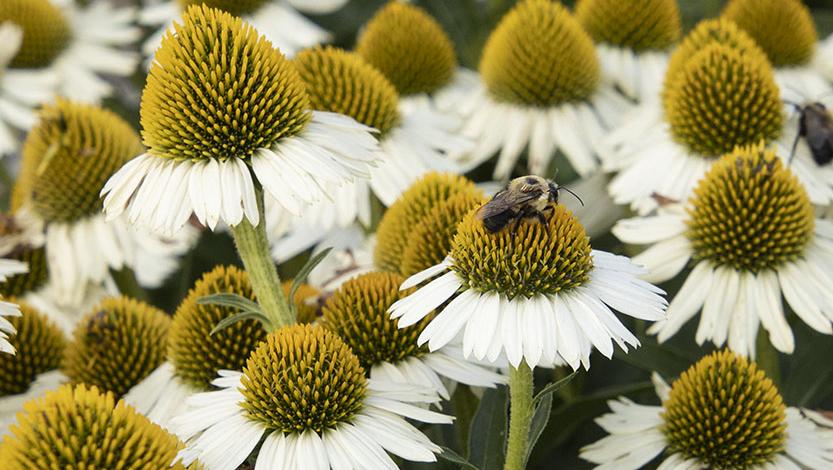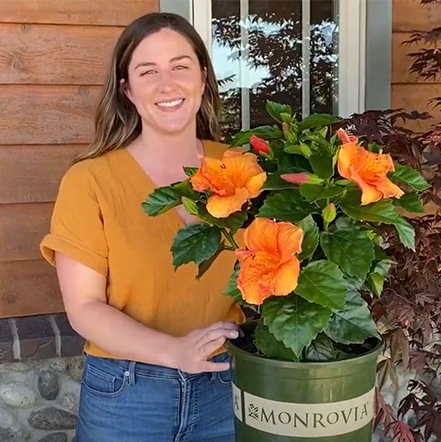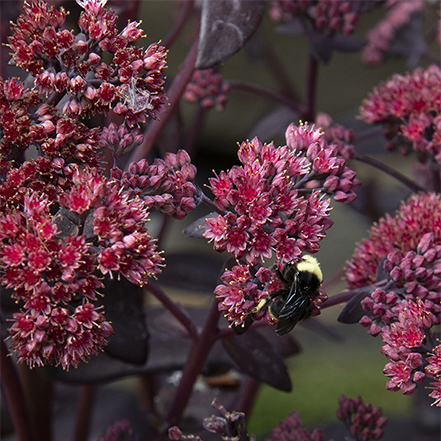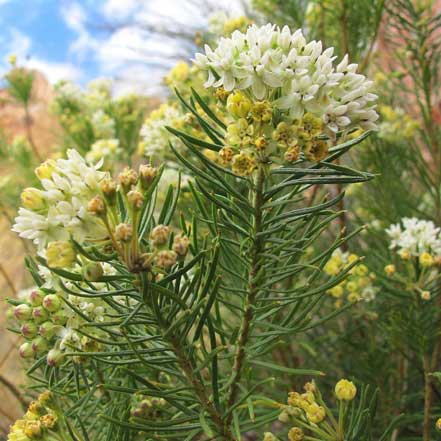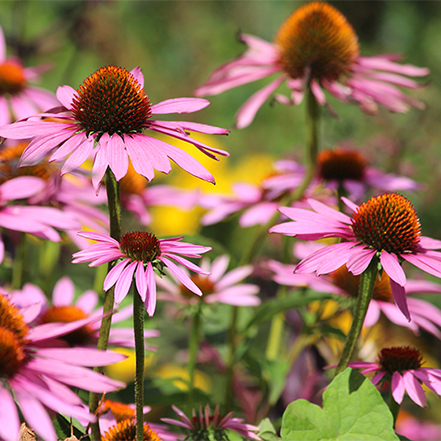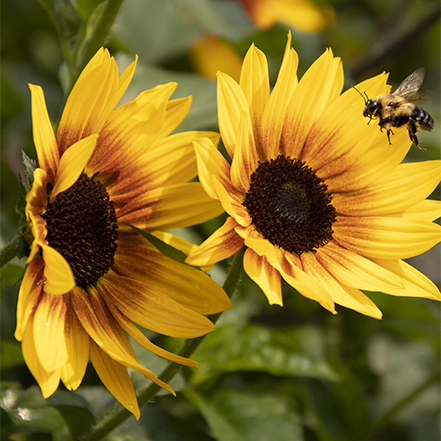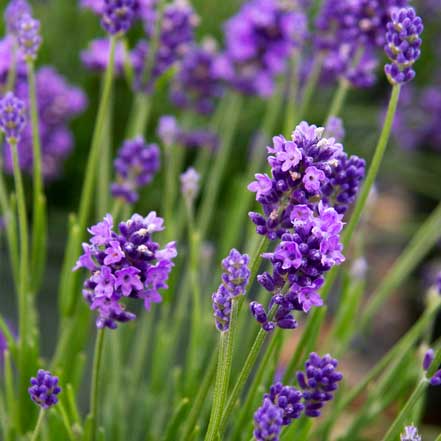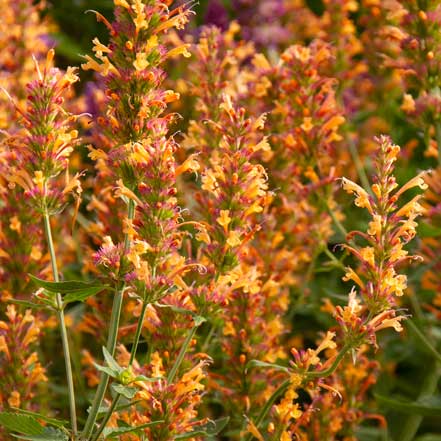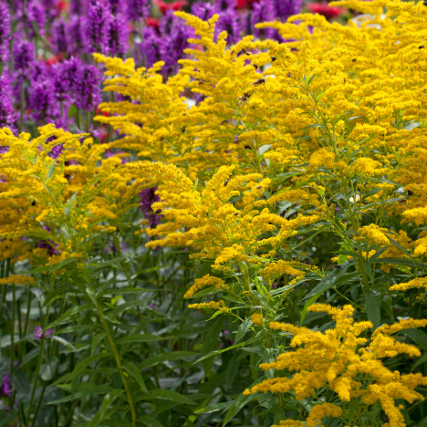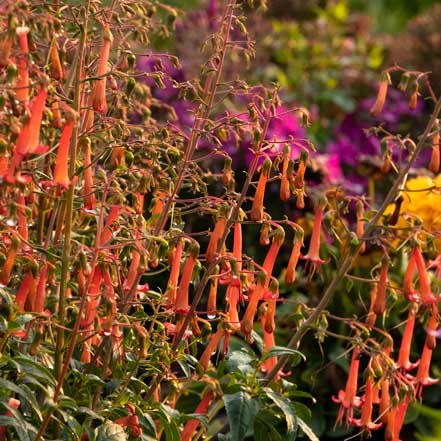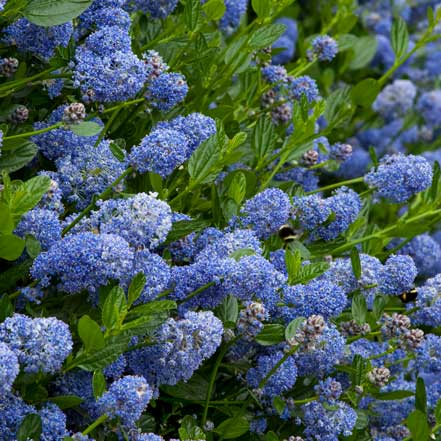Trying to attract more butterflies, hummingbirds, and bees to your garden? You're not alone. More and more gardeners are realizing the importance of beneficial insects and wildlife to their ecosystems, and are growing plants that support them. Plus, it's just more fun to see a garden alive with butterflies, bees, and hummingbirds!
Monrovia grows thousands of plants that support pollinators, and all of our nurseries use pollinator-friendly growing methods. We love seeing a garden buzzing with life and want to make it easier for you to do the same by providing a myriad of pollinator-friendly plant options. Before we reveal our favorite plants for a colorful garden that's full of life, let's start with the basics.
What are pollinator plants?
Pollinator plants (a.k.a. pollinator-friendly plants) are flowering perennials, annuals, or shrubs that provide the nectar and pollen essential for a flourishing pollinator population. Pollinators include hummingbirds, butterflies, bees, and other beneficial insects. Pollinator plants maintain a healthy pollinator population, which allows for crops and flowers to continue producing seeds and fruits via insect pollination (as well as a healthy garden and vibrant ecosystem).
What is a pollinator garden?
A pollinator garden is an outdoor space that is filled with plants that provide a source of nectar and pollen to the local pollinator population. Pollinator gardens can be large landscapes or small patio container gardens. If a space is filled mostly with pollinator-friendly plants, it can be considered a pollinator garden. Pollinator gardens are made even better by providing a water source, nesting sites, and following other insect-friendly approaches outlined in this article.
Ready to get started bringing more hummingbirds, butterflies, and bees to your garden? We have some fantastic plant ideas for you below.
The Best Plants for Pollinator-Friendly Gardens
There are so many options when it comes to plants that attract pollinators. It can be overwhelming to make a choice. That's why we asked one of our very own plant experts, Monrovia New Plants Manager, Georgia Clay, to name her very favorite pollinator plants in order to narrow it down.
Georgia is devoted to finding the best pollinator-friendly plants around and making them available to gardeners across the country. She says, "we’re always looking for new plants that bees and butterflies love because we know home gardeners are looking for more ways to support them.”
Below is Georgia's list of her favorite pollinator plants, as well as an explanation for why they made the list. You can take a look at more of her favorite plants on YouTube. Let us know your favorites in the comments, or share with us on social media @MonroviaPlants.
Georgia says: I particularly like the groundcover types of Sedum because they are easy to tuck into plantings and can fill the spaces between other plantings with beautiful foliage and pollinator-friendly flowers. Bees have a hard time pollinating in windy weather so the lower the flowers are to the ground, the better!
Pictured left: Evolution™ Chocolate Fountain Sedum is a sturdy, compact, and dense sedum that offers deep-rose blooms for bees and chocolate-colored succulent foliage for the keen-eyed gardener. Up to 15" tall and wide. Zones 4-9.
Georgia says: Milkweed might be best known as being the only source of food for monarch butterfly larvae, but it is also a great source of nectar for many other species of butterflies and bees.
It's important to grow a variety native to your area in order to support monarch butterflies in your region. Search milkweed varieties here to find a variety suited to your area.
Pictured Left: Monarch Magnet Pineleaf Milkweed is a Southwestern native that has a dense growth habit with narrow, conifer-like leaves. The white flowers are showier than the species type. Perfect for pollinator, butterfly, and wildlife gardens in warm climates. Up to 3' tall and wide. Zones 9-11.
Georgia says: There are so many Echinacea varieties available on the market that will suit any garden and most all have an exceptionally long bloom period and provide bees with both nectar and pollen. Evolution™ Colorific™ Coneflower is a prolific bloomer and dependable performer in nearly any garden zones 4-9.
Pictured left: Magnus Purple Coneflower is an easy-care variety that closely resembles the native species (making it perfect for pollinators and wildlife). The magenta-rose blooms feature petals that reach horizontally rather than pendulously, making them look big and bold in the garden. A butterfly favorite! Up to 3' tall and wide. Zones 4-9.
Georgia says: Sunflowers are the happiest flower in the garden, in my opinion. They are a great source of nectar for native bees and honeybees. Varieties that put on masses of flowers and bloom late into the year, like SunBelievable™, provide an outstanding source of reliable late-season nectar.
Pictured left: SunBelievable Brown Eyed Girl Helianthus is a seedless annual that blooms prolifically from spring until first frost. The yellow petals are dashed with red around the brown center. Bees love these sunny flowers and their non-stop nectar source. Up to 32" tall and 40" wide. Grows as an annual in all zones.
Georgia says: I love incorporating lavender into my perennial and herb beds. The fragrance is fantastic and it is super fun to watch the bumblebees in their ‘pollen pants’ enjoying the beautiful flowers.
Pictured left: Thumbelina Leigh English Lavender is an aromatic, compact variety with low water needs and prolific blooms that attract pollinators. A favorite for containers, rock gardens, and narrow spaces. Up to 18" tall and 12" wide. Zones 5-9.
Georgia says: Agastache is gorgeous planted in mass and will attract loads of bees and hummingbirds to the garden. They have a long bloom time and aromatic foliage so deer tend not to munch.
Pictured left: Kudos Gold Dwarf Agastache is a waterwise perennial and prolific bloomer that's perfect for gardens in warm, dry climates. The upright flowers bloom in shades of gold from summer through fall. Up to 26" tall and wide. Zones 5-10.
Georgia says: I really love Goldenrod's fluffy bright-gold flowers and carefree look in perennial gardens. Goldenrod is an important food source for migrating monarch butterflies in the fall as well as many species of bees, beneficial wasps, and beneficial flies.
Pictured left: Crown of Rays Goldenrod is an easy-care pollinator magnet that provides much-needed color and nectar at the end of the season. Yellow-gold, flattened panicle flowers cover the plant at the end of summer and persist through fall. Up to 3' tall by 2' wide. Zones 4-8.
Georgia says: Phygelius, or Cape Fuchsia, is a hardy perennial Fuchsia with gorgeous tubular flowers that hummingbirds love. Many varieties tend to flop in the garden, but Colorburst™ does a good job of staying upright which allows the hummingbirds to enjoy for even longer!
Pictured left: Colorburst™ Orange Cape Fuchsia has a bushy, upright growth habit that explodes in fireworks of orange, tubular flower clusters from midsummer to fall. Spreads through underground stems. Up to 3' tall by 2' wide. Zones 6-10.
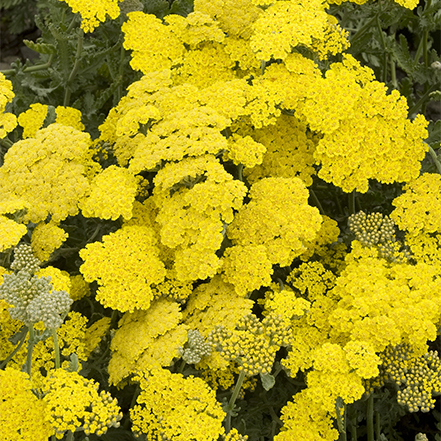
Georgia says: Achillea is fantastic for attracting beneficial insects like hoverflies, lacewings, and ladybugs that love to feast on garden pests like aphids, mealybugs, and mites. They add a really nice texture to the garden with their unusual flat flowers and fern-like foliage.
Pictured Left: Moonshine Yarrow has ferny, gray-green foliage, upright stems, and canary-yellow blooms that pollinators and beneficial insects adore. This is a low-maintenance, low-water perennial that is perfect for the hot, dry summers of the west. Up to 2' tall and wide. Zones 3-9.
Georgia says: Ceanothus is loaded with beautiful blue flowers in the spring that almost seem to vibrate with pollinators. This shrub also gets bonus points for having gorgeous evergreen foliage that is dark green and incredibly glossy!
Pictured left: Victoria California Lilac is an evergreen shrub that's ideal for adding color and tall, foundational structure to warm coastal gardens. Blue flowers cover the shrub in spring, offering abundant nectar as pollinators become more active at the start of the season. Up to 9' tall and 12' wide. Zones 8-10.
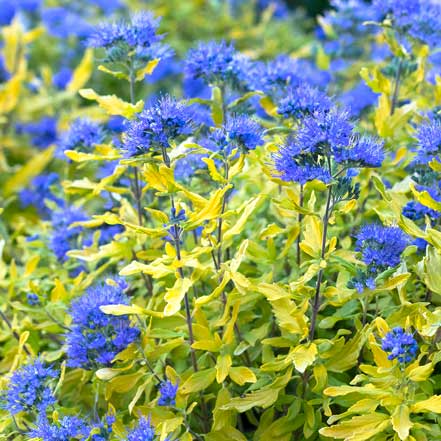
Georgia says: Caryopertis bloom in the late summer and into the fall. They are a great source of nectar in the fall when pollinators need it most and options are more limited.
Pictured left: La Barbe Bleue™ Bluebeard is a low-water, easy-care, and pollinator-friendly shrub that is a perfect addition to pollinator, prairie, and wildlife gardens in cool-to-mild climates. The deep-blue flowers are striking against the chartreuse foliage, and together they light up the garden with their dramatic contrast. Up to 36" tall by 30" wide. Zones 5-9.




